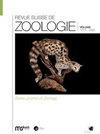Atlas of Australasian hormurid scorpions. I. The genus Hormurus Thorell, 1876 in Papua New Guinea. Exceptional morphological diversity in male and female copulatory structures suggests genital coevolution
IF 0.5
4区 生物学
Q4 ZOOLOGY
引用次数: 0
Abstract
Abstract: New Guinea is the largest Pacific island, and the world's second largest, with a land area of about 785,000 km2. Located north of Australia, the island was gradually shaped since the Eocene by the geologically recent sequential accretion of several island arc systems onto the northern part of the Australian Craton. This complex geological history has resulted in a tremendous biological diversity with high rates of endemism. On the other hand, the rugged mountainous landscape and lack of infrastructure has hampered scientific research in the country and for the most part Papuan biotas remain thus far only superficially known. This is the case for scorpions of the genus Hormurus Thorell, 1876 (Hormuridae Laurie, 1896; Scorpiones C. L. Koch, 1837). Although they are the dominant scorpion group in Wallacea and Melanesia, only two species are currently recognized from New Guinea and its adjacent islands. A thorough revisionary study of the Hormurus material present in the scientific collections of various museums and of a large series of specimens more recently collected led to the discovery of 16 new species, i.e. Hormurus ancylolobus Monod & Prendini, sp. nov.; Hormurus araiaspathe Monod & Prendini, sp. nov.; Hormurus barai Monod, Iova & Prendini, sp. nov.; Hormurus cameroni Monod, Austin & Prendini, sp. nov.; Hormurus hypseloscolus Monod & Prendini, sp. nov.; Hormurus krausi Monod & Prendini, sp. nov.; Hormurus maiwa Monod & Prendini, sp. nov.; Hormurus menapi Monod & Prendini, sp. nov.; Hormurus muyua Monod & Prendini, sp. nov.; Hormurus oyatabu Monod & Prendini, sp. nov.; Hormurus oyawaka Monod & Prendini, sp. nov.; Hormurus sibonai Monod & Prendini, sp. nov.; Hormurus slapcinskyi Monod & Prendini, sp. nov.; Hormurus sporacanthophorus Monod & Prendini, sp. nov.; Hormurus tagula Monod & Prendini, sp. nov.; Hormurus yela Monod & Prendini, sp. nov. Fully illustrated descriptions of these new taxa are presented in the present contribution, as well as a redescription of Hormurus papuanus Kraepelin, 1914. Hormurus species are characterized by relatively few diagnostic external characters which hampers species differentiation. However, the unusual interspecific diversity of hemispermatophores observed in Papuan taxa partially alleviate this issue and enable reliable species discrimination. The position of the laminar hook is particularly variable and is correlated with the elongation of the female genital operculum which also shows an atypical diversity for the genus. This interdependence strongly suggests genital coevolution driven by a lock-and-key mechanism. This would be the first such case reported for the order Scorpiones Koch, 1837. Multivariate and geometric morphometric analyses were carried out to visually emphasize subtle interspecific differences in external morphology and hemispermatophore morphology. Additionally, the correlation between hemispermatophore laminar hook position and shape of the female genital operculum was assessed statistically and comments are provided concerning potential mechanisms underlying the coevolutionary process.澳大利亚荷尔蒙蝎子图谱。I. 巴布亚新几内亚的 Hormurus Thorell,1876 年属。雌雄交配结构的异常形态多样性表明生殖器是共同进化的
摘要:新几内亚是太平洋最大的岛屿,也是世界第二大岛,陆地面积约 78.5 万平方公里。该岛位于澳大利亚以北,自始新世以来,澳大利亚克拉通北部的几个岛弧系统在地质学上相继增生,逐渐形成了该岛。这一复杂的地质历史造就了生物的巨大多样性和极高的特有率。另一方面,崎岖的山地地貌和基础设施的缺乏阻碍了该国的科学研究,迄今为止,人们对巴布亚生物的了解大多还停留在表面。Hormurus Thorell, 1876(Hormuridae Laurie, 1896; Scorpiones C. L. Koch, 1837)属的蝎子就是这种情况。虽然它们是瓦拉塞斯和美拉尼西亚的主要蝎子类群,但目前在新几内亚及其邻近岛屿仅发现两个物种。通过对各博物馆科学收藏的 Hormurus 材料以及最近采集的大量标本进行彻底的修订研究,发现了 16 个新种,即Hormurus ancylolobus Monod & Prendini,新种;Hormurus araiaspathe Monod & Prendini,新种;Hormurus barai Monod,Iova & Prendini,新种;Hormurus cameroni Monod,Austin & Prendini,新种;Hormurus hypseloscolus Monod & Prendini,新种;Hormurus kraus Monod & Prendini,新种。Hormurus maiwa Monod & Prendini, sp.Hormurus slapcinskyi Monod & Prendini, sp.本文对这些新分类群进行了图文并茂的描述,并对 Hormurus papuanus Kraepelin, 1914 进行了重新描述。Hormurus 种的特征是具有相对较少的外部诊断特征,这阻碍了种的区分。然而,在巴布亚类群中观察到的不同寻常的种间半精巢多样性部分缓解了这一问题,使可靠的物种鉴别成为可能。片状钩的位置尤其多变,并且与雌性生殖器厣的伸长相关,而雌性生殖器厣的伸长在该属中也表现出非典型的多样性。这种相互依存的关系强烈表明,生殖器的共同进化是由锁钥机制驱动的。这将是蝎形目(Scorpiones Koch, 1837)首次报道此类情况。我们进行了多变量和几何形态分析,以直观地强调种间在外部形态和半精巢形态上的微妙差异。此外,还对半精巢层钩位置与雌性生殖器厣形状之间的相关性进行了统计评估,并就共同进化过程的潜在机制提出了意见。
本文章由计算机程序翻译,如有差异,请以英文原文为准。
求助全文
约1分钟内获得全文
求助全文
来源期刊

Revue Suisse de Zoologie
生物-动物学
CiteScore
1.30
自引率
12.50%
发文量
25
审稿时长
>12 weeks
期刊介绍:
The Revue suisse de Zoologie is a biannual journal published by the Geneva Museum and the Swiss Zoological Society. The Swiss Academy of Sciences and the City of Geneva provide financial support to the journal.
The Revue suisse de Zoologie publishes original results of zoological research, particularly in systematics and related fields.
 求助内容:
求助内容: 应助结果提醒方式:
应助结果提醒方式:


